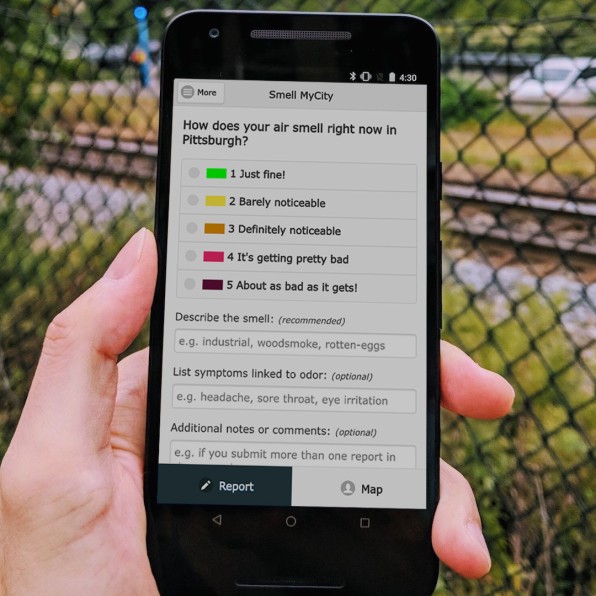How Do You Restart Bloons Monkey City App If You Don't Like Your City
Sniff. Do you smell that? Sniff. You don't? Sniff. How is that possible? Sniff. It's like . . . someone shoved rotten garbage up my nostrils! Sniff. Seriously? You don't smell that?
We've all been there, walking down the street when we smelled something truly terrible. Usually, there's nothing we can do about it, other than ask a friend if they smell it, too. But today that changes with the launch of Smell MyCity. It's an app for iOS and Android that lets you report a bad smell anywhere in the U.S. In a few cases, those reports are sent directly to local air authorities. But for the most part, your reports become part of an easily downloadable open data set that you and your neighbors can bring with you to the next community board meeting.

Smell MyCity hails from Carnegie Mellon University's CREATE Lab. The new app is sponsored by Seventh Generation, and it's an extension of the lab's Smell Pittsburgh app that was released in 2017. As you'd expect, Smell Pittsburgh allowed you to report smells in Pittsburgh. Smell MyCity is national.
"Smell is one case where our human senses are powerful to picking up what's in the air," says project director Beatrice Dias, "as scents like sulfur don't just smell like rotten eggs–they can be detrimental to our health. "It's important for us to pay attention to what our body is telling us. The app tries to highlight those experiences."
When you load the app, GPS spots your location. So all it needs to do is ask you a simple question: How does the air smell around you right now? The numerical ratings range from 1 ("It's fine!") to a 5 ("It's about as bad as it gets!"). You can also detail the odor–which you are encouraged to do–and list symptoms like burning eyes that might be coming as a result. After reporting, you're free to peruse the local map to spot other bad smells in the area–to either avoid or go smell yourself.
Dias tells us that her team has learned a lot over the past two years since Smell Pittsburgh launched. So far, 4,500 people have installed the app, creating 20,000 smell reports–each of which have been emailed to local pollution authorities. "The main success is that people still use the app!" she says. "This year has been pretty smelly already in Pittsburgh."
With Smell MyCity, the team was after scale. Transitioning to a nationwide map and personalizing screens to your city wasn't too difficult. Partnerships on the national scale are harder. The lab did partner with the city of Louisville, Kentucky, so that reports could go directly to regulators in the area. For everyone else, your data is uploaded to a public data set. On the Smell MyCity site, you can look at a map of your area, or download the data in a spreadsheet.
"You wouldn't be connected to a local regulatory agency in that case, but you can still encourage your neighbor to start filing reports," says Dias. "As the community starts reporting, you can download the data and use it for your advocacy." And really, there's no reason not to use Smell MyCity if bad smells are a problem in your town.
While Smell Pittsburgh data is routinely referenced in city meetings, Dias admits she can't point to any particular legislation that's passed as a result of the project. That doesn't surprise her. "It can be frustrating because you see you've been reporting something for two years and it still smells bad," she says. "That's frustrating for many people. Things move very slowly, especially with air quality. But keep 'em coming."
How Do You Restart Bloons Monkey City App If You Don't Like Your City
Source: https://www.fastcompany.com/90326996/report-stinky-spots-in-your-city-with-this-free-app
Posted by: clementwrapprand.blogspot.com

0 Response to "How Do You Restart Bloons Monkey City App If You Don't Like Your City"
Post a Comment